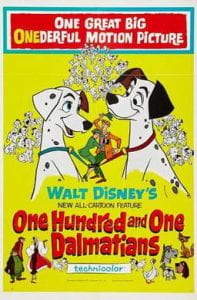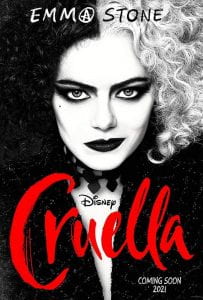If I had to describe Cruella (2021) in one word, it would be unexpected. Everything about it — from its sympathetic portrayal of one of Disney’s most iconic villains to its 1970s London setting — feels like a curveball. But what most surprised me about this film wasn’t its third act plot twist or its surprisingly good soundtrack. The most unexpected thing was that Cruella is surprisingly true to the spirit of the original version of One Hundred and One Dalmatians (1961).
This makes more sense when you consider all of the surface-level similarities that these two films share. One Hundred and One Dalmatians features voiceover narration from its protagonist, a Dalmatian named Pongo; Cruella features voiceover narration from its titular villain. The tone of the narration is the same in both films: witty, intelligent, but not so intellectual as to take away from the pleasure of telling a good story. Both films take place in the past, “not so long ago” from the first film’s 1961 release date in the words of Pongo and the 1970s in Cruella. The similarities even extend to using television as a way to add to both film’s sense of worldbuilding. Many characters in One Hundred and One Dalmatians watch TV shows which satirize then-contemporary trends in television (as pointed out in this brilliant essay on the film from CrimeReads) and in Cruella the titular character briefly watches Tallulah Bankhead, one of the original sources of inspiration for the look of Cruella, on television.

But more than anything, what the two films share is a desire to subvert traditional societal expectations. For example, One Hundred and One Dalmatians repeatedly depicts animals as being smarter than humans. Pongo is so highly capable that it makes sense that he repeatedly refers to Roger as his “pet.” When the puppies of Pongo and his wife Perdita are stolen, it is not ineffectual efforts made by humans which find them, but the highly competent work of a network of animals known as the “Twilight Bark.” When humans are depicted in this film, it is not as brilliant apex predators. Instead, they fall into two camps. The first one is full of people who are kind but not as smart as animals, such as Roger and Anita. Those in the second camp are evil and prone to failure, perhaps best exemplified by Cruella de Vil.

It is fitting that a film which is about looking at life through a different point-of-view would inspire another film that looks at a familiar character through a different point-of-view. In the original One Hundred and One Dalmatians, Cruella de Vil is a vain antagonist. She seeks to murder dozens of puppies to make fur coats, arguably one of the most despicable things a Disney villain has ever wanted to do. One Hundred and One Dalmatians asks people who watch it to laugh at Cruella’s excesses and cheer her failures. But the film Cruella, a prequel to One Hundred and One Dalmatians, presents an entirely different portrait of her. In this more recent film, Cruella is a working-class orphan who wants to seek (non-lethal) revenge for the murder of her mother. Like Pongo, she is much smarter than her opponents. The film invites us to laugh with her as she defeats them, as opposed to laughing at her as people did in One Hundred and One Dalmatians. The film makes such a persuasive case for liking Cruella (wonderfully played by a charismatic Emma Stone) that you wonder what a live-action remake of One Hundred and One Dalmatians from her perspective would look like.
Ultimately, what I love about these films is how they look at things from a different perspective. One Hundred and One Dalmatians has some of the most beautiful animation I’ve ever seen, but at its core, it tells a story about not underestimating the intelligence and strength of animals. Cruella has excellent cinematography, but what makes it memorable is how it takes its source material’s spirit of plucky outsiders triumphing over adversity and applies it to one of Disney’s most infamous villains. Both films are reminders that, when it comes to storytelling, sometimes the best point-of-view comes from the underdog.
IU Cinema will be screening the 1996 version of 101 Dalmatians at Memorial Stadium on September 30 as part of the Glenn Close and The Art of the Character, CINEkids, and IU Cinema Under the Stars series. The Monroe County Humane Association will have members of its Animal Therapy Team from 7–8 pm to welcome everyone to the screening. This is a great chance for you to get some off-screen puppy love and learn more about the services and programs MCHA provides for the community!

Jesse Pasternack is a graduate of Indiana University. During his time at IU, Jesse was the co-president of the Indiana Student Cinema Guild. He also wrote about film, television, and pop culture for the Indiana Daily Student. Jesse has been a moderator at Michael Moore’s Traverse City Film Festival and is a friend of the Doug Loves Movies podcast. An aspiring professional writer-director, his own film work has appeared at Campus Movie Fest and the Anthology Film Archives in New York City.

